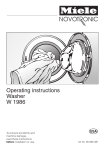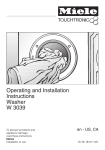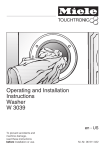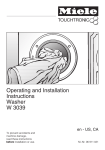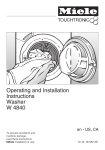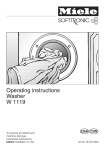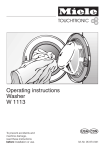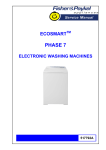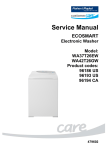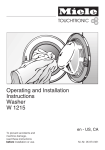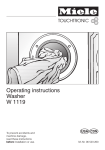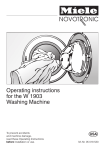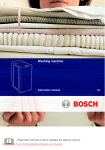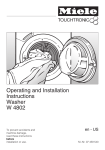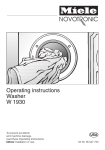Download Miele W 1966 Washer User Manual
Transcript
Operating instructions Washer W 1966 To prevent accidents and machine damage, read these instructions before installation or use. V M.-Nr. 05 631 101 Contents IMPORTANT SAFETY INSTRUCTIONS . . . . . . . . . . . . . . . . . . . . . . . . . . . . . . . . . 4 Quick Guide. . . . . . . . . . . . . . . . . . . . . . . . . . . . . . . . . . . . . . . . . . . . Centrer pages Guide to the washer. . . . . . . . . . . . . . . . . . . . . . . . . . . . . . . . . . . . . . . . . . . . . . . . 5 Control panel . . . . . . . . . . . . . . . . . . . . . . . . . . . . . . . . . . . . . . . . . . . . . . . . . . . . . . 5 Before using the washer . . . . . . . . . . . . . . . . . . . . . . . . . . . . . . . . . . . . . . . . . . . . 6 Using the washer . . . . . . . . . . . . . . . . . . . . . . . . . . . . . . . . . . . . . . . . . . . . . . . . . . 7 1. Prepare and sort laundry . . . . . . . . . . . . . . . . . . . . . . . . . . . . . . . . . . . . . . . . . . . 7 2. Load the laundry . . . . . . . . . . . . . . . . . . . . . . . . . . . . . . . . . . . . . . . . . . . . . . . . . 8 3. Select a program . . . . . . . . . . . . . . . . . . . . . . . . . . . . . . . . . . . . . . . . . . . . . . . . . 9 Special programs. . . . . . . . . . . . . . . . . . . . . . . . . . . . . . . . . . . . . . . . . . . . . . . . . . . 9 Program guide . . . . . . . . . . . . . . . . . . . . . . . . . . . . . . . . . . . . . . . . . . . . . . . . . . . . 10 4. Select a spin speed . . . . . . . . . . . . . . . . . . . . . . . . . . . . . . . . . . . . . . . . . . . . . . 11 5. Select wash options (if needed) . . . . . . . . . . . . . . . . . . . . . . . . . . . . . . . . . . . . 12 6. Add detergent . . . . . . . . . . . . . . . . . . . . . . . . . . . . . . . . . . . . . . . . . . . . . . . . . . 13 Detergent . . . . . . . . . . . . . . . . . . . . . . . . . . . . . . . . . . . . . . . . . . . . . . . . . . . . . . . 14 Water softener . . . . . . . . . . . . . . . . . . . . . . . . . . . . . . . . . . . . . . . . . . . . . . . . . . . . 14 Fabric softener . . . . . . . . . . . . . . . . . . . . . . . . . . . . . . . . . . . . . . . . . . . . . . . . . . . . 15 Starch. . . . . . . . . . . . . . . . . . . . . . . . . . . . . . . . . . . . . . . . . . . . . . . . . . . . . . . . . . . 15 Using the "Starch" program . . . . . . . . . . . . . . . . . . . . . . . . . . . . . . . . . . . . . . . . . . 15 Fabric dye . . . . . . . . . . . . . . . . . . . . . . . . . . . . . . . . . . . . . . . . . . . . . . . . . . . . . . . 15 Using the washer . . . . . . . . . . . . . . . . . . . . . . . . . . . . . . . . . . . . . . . . . . . . . . . . . 16 7. Start the program . . . . . . . . . . . . . . . . . . . . . . . . . . . . . . . . . . . . . . . . . . . . . . . . 16 8. Activate the program lock (if necessary) . . . . . . . . . . . . . . . . . . . . . . . . . . . . . . 16 9. Unload the laundry . . . . . . . . . . . . . . . . . . . . . . . . . . . . . . . . . . . . . . . . . . . . . . 17 Adding/removing laundry during a wash program . . . . . . . . . . . . . . . . . . . . . . . . 18 Cancelling a program that has not yet started . . . . . . . . . . . . . . . . . . . . . . . . . . . 18 Cancelling a program that has started . . . . . . . . . . . . . . . . . . . . . . . . . . . . . . . . . 19 Making changes to the program . . . . . . . . . . . . . . . . . . . . . . . . . . . . . . . . . . . . . . 19 Skipping part of a program . . . . . . . . . . . . . . . . . . . . . . . . . . . . . . . . . . . . . . . . . . 19 To change a program. . . . . . . . . . . . . . . . . . . . . . . . . . . . . . . . . . . . . . . . . . . . . . . 19 2 Contents Locking the washer . . . . . . . . . . . . . . . . . . . . . . . . . . . . . . . . . . . . . . . . . . . . . . . 20 Electronic program lock. . . . . . . . . . . . . . . . . . . . . . . . . . . . . . . . . . . . . . . . . . . . . 20 Child Safety Lock . . . . . . . . . . . . . . . . . . . . . . . . . . . . . . . . . . . . . . . . . . . . . . . . . . 21 Washer care . . . . . . . . . . . . . . . . . . . . . . . . . . . . . . . . . . . . . . . . . . . . . . . . . . . . . 22 Cleaning the washer . . . . . . . . . . . . . . . . . . . . . . . . . . . . . . . . . . . . . . . . . . . . . . . 22 Cleaning the detergent drawer . . . . . . . . . . . . . . . . . . . . . . . . . . . . . . . . . . . . . . . 22 Cleaning the drain pump and lint trap . . . . . . . . . . . . . . . . . . . . . . . . . . . . . . . . . . 23 Cleaning the water inlet filters . . . . . . . . . . . . . . . . . . . . . . . . . . . . . . . . . . . . . . . . 25 Cleaning the inlet hose filter . . . . . . . . . . . . . . . . . . . . . . . . . . . . . . . . . . . . . . . . . 25 Cleaning the filter in the inlet valve . . . . . . . . . . . . . . . . . . . . . . . . . . . . . . . . . . . . 25 Frequently asked questions . . . . . . . . . . . . . . . . . . . . . . . . . . . . . . . . . . . . . . . . 26 The program will not start. . . . . . . . . . . . . . . . . . . . . . . . . . . . . . . . . . . . . . . . . . . . 26 The program stops and a fault indicator blinks. . . . . . . . . . . . . . . . . . . . . . . . . . . 26 The program runs normally but a fault indicator lights up. . . . . . . . . . . . . . . . . . . 27 Poor wash results. . . . . . . . . . . . . . . . . . . . . . . . . . . . . . . . . . . . . . . . . . . . . . . . . . 28 The door will not open when the "Door" button is pressed. . . . . . . . . . . . . . . . . . . 30 Opening the drum door during a power failure . . . . . . . . . . . . . . . . . . . . . . . . . . 31 After Sales Service . . . . . . . . . . . . . . . . . . . . . . . . . . . . . . . . . . . . . . . . . . . . . . . 32 PC Update . . . . . . . . . . . . . . . . . . . . . . . . . . . . . . . . . . . . . . . . . . . . . . . . . . . . 32 Installation instructions . . . . . . . . . . . . . . . . . . . . . . . . . . . . . . . . . . . . . . . . . . . 33 3 IMPORTANT SAFETY INSTRUCTIONS ,WARNING - To reduce the risk of fire, electric shock, or injury to persons while using your appliance, follow basic safety precautions, including the following: Read all instructions before using the appliance. GROUNDING INSTRUCTIONS This appliance must be grounded. In the event of malfunction or breakdown, grounding will reduce the risk of electric shock by providing a path of least resistance for electric current. This appliance is equipped with a cord having an equipment-grounding conductor and a grounding plug. The plug must be plugged into an appropriate outlet that is properly installed and grounded in accordance with all local codes and ordinances. WARNING - Improper connection of the equipment-grounding conductor can result in a risk of electric shock. Check with a qualified electrician or serviceman if you are in doubt as to whether the appliance is properly grounded. Do not modify the plug provided with the appliance - if it will not fit the outlet, have a proper outlet installed by a qualified electrician. Do not wash articles that have been previously cleaned in, washed in, soaked in, or spotted with gasoline, dry-cleaning solvents, or other flammable or explosive substances, as they give off vapors that could ignite or explode. Do not add gasoline, dry cleaning solvents, or other 4 flammable or explosive substances to the wash water. These substances give off vapors that could ignite or explode. Under certain conditions, hydrogen gas may be produced in a hot water system that has not been used for 2 weeks or more. HYDROGEN GAS IS EXPLOSIVE. If the hot water system has not been used for such a period, before using the washing machine, turn on all hot water faucets and let the water flow from each for several minutes. This will release any built up hydrogen gas. As the gas is flammable, do not smoke or use an open flame during this time. Do not allow children to play on or in the appliance. Close supervision is necessary when the appliance is used near children. Before the appliance is removed from service or discarded, remove the door. Do not reach into the appliance if the drum is moving. Do not install or store this appliance where it will be exposed to the weather. Do not tamper with the controls. Do not repair or replace any part of the appliance, or attempt any servicing unless specifically recommended in these Operating Instructions. SAVE THESE INSTRUCTIONS Guide to the washer Control panel 1 "On/Off" button turns the machine on and off or interrupts a program. 5 Spin speed selector button allows you to select the final spin speed of a program. 2 "Door" button opens the drum door. 6 Spin speed indicator light 3 "START" button begins the wash program. 7 Program selector for selecting a program and wash temperature. 4 Wash options are special wash features available to enhance a wash program. The light ring will go out a few minutes after the end of the program to save energy. 8 Program sequence display shows the currect cycle of the wash program. 9 Fault indicators 5 Before using the washer The appliance must be correctly installed and connected before the first use. Please see the "Installation instructions." Before using the washer, a program must be run without laundry and without detergent to flush out any residual water from the factory testing process. ^ Close washer door. ^ Press in the "On/Off" button. ^ Turn the program selector to "COTTONS/very hot". ^ Press the "Spin" button until the "900" mark of the indicator lights. ^ Press the "START" button. Once the program ends the washer can be used for laundry. 6 Using the washer 1. Prepare and sort laundry – Dark fabrics often "bleed" the first few times they are washed. They should be washed separately several times before being included in a mixed load. – Remove any lead weights or strips from curtains before washing. – Loose bra underwires should be removed or sewn in place before washing. – Woolens and knitted garments should be turned inside out. ^ Empty all pockets. – Close zippers, hooks and eyelets before washing. ,Foreign objects left in pockets (e.g. nails, coins, paper clips, etc.) can cause damage to clothes and the machine. ^ Sort the laundry. Only wash items that are labeled machine washable by the manufacturer. Most garments have a fabric care label in the collar or side seam. Sort the laundry by care label and color. ^ Pretreat stains. Tough stains (blood, egg, coffee, tea etc.) or badly soiled areas (collars and cuffs) should be pretreated with a stain remover or a paste made from powder detergent and warm water. 7 Using the washer 2. Load the laundry ^ Turn on the washer using the "On/Off" button. ^ Open the drum door using the "Door" button. ^ Load the laundry into the drum. For best results, wash mixed loads of small and large items. This will improve washing effectiveness and help distribute the load evenly. Note: Overloading the washer will affect wash results and cause wrinkling. ^ Close the drum door. To prevent damage to the door seal and clothing, make sure that there are no clothes caught between the drum door and the seal. 8 Using the washer 3. Select a program Special programs SILK / Gentle program for hand and machine washable silk fabrics. Cool water and slower wash, rinse, and spin cycles reduce wrinkling and fading. WOOLENS / ^ Turn the program selector in either direction to the program you wish to use. Specialty care program for hand and machine washable wool and wool blends. A mild range of wash temperatures, low water level and minimum drum movement gently clean and maintain the shape of garments. Jeans Specially designed program that washes denim materials at the correct temperature to release stains and at a spin speed that prevents wrinkles. Dress shirts Program for cleaning dress shirts with reduced wrinkling. Fine rinse Laundry is only rinsed and spun in this program. Starch This program is for starching without washing. See "Detergent/ Using the "Starch" program" for details. 9 Using the washer Program guide Temperature Cottons Care symbols Fabric Available wash options: Soak, Heavy soil, Extended, Sensitive 95 °C / very hot F 60 °C / hot 50 °C / hot – white household linens 100 % cotton sheets, cloth diapers, towels, etc. to be sanitized. Not for use with clothing with elastic. 8 – sturdy white cottons Underwear, cotton t-shirts, socks. E C light colors Colorfast items. 40 °C / warm 7 B bright colors 20 °C / cold 6 A dark colors PERMA PRESS Black items, mixed loads. Available wash options: Soak, Heavy soil, Extended, Sensitive 60 °C / hot 8 – 50 °C / warm E C light colors 40 °C / warm 7 B bright colors 20 °C / cold 6 A dark colors & tempera- Spandex, microfibers, etc. ture sensitive fabrics whites For cotton blends, easy-care cottons, wrinkle-free items. Polyester blends and synthetics such as acrylic, nylon, ramie. Fabric softener can be dispensed in the final rinse of these programs to reduce static cling. Drain / Spin No available wash options DELICATES Available wash options: Soak, Heavy soil, Extended 40 °C / warm 7 B light colors 30 °C / cold 6 A dark colors cold / cold 6 – SILK ß / cold WOOLENS lace or sheer fabrics, embroidered items. No available wash options 6 A silk and silk blends, lingerie and hosiery 7 B light colors 30 °C / cold 6 A dark colors – – Jeans 40 °C Dress shirts 40 °C For hand washable and machine washable wool and wool blends (e.g. lamb’s wool, chashmere, mohair, angora, etc.) delicate woolens No available wash options 7 B denim Available wash options: Soak, Heavy soil, Extended 7 B Starch No available wash options Fine rinse No available wash options 10 Ideal for machine and hand washable silks and other non-wool handwashable garments No available wash options 40 °C / warm cold / cold For synthetics, machine washable silks, satin, hosiery, lingerie, lace or crocheted (non-wool) items, curtains and knits. Using the washer 4. Select a spin speed Special spin options – Hold Laundry is not spun and remains soaking in water. This will prevent wrinkles if the laundry is not removed immediately at the end of the wash program. When ready, select a spin speed to continue the program. To finish the program: Press the "Door" button. – No spin The default spin speed will automatically be selected for each program. However, you can adjust the spin speed within the parameters listed below. ^ Press the "Spin" button until the indicator for the desired spin speed lights. Available spin speeds The laundry is not spun after the final rinse but the water is drained away. After the drain cycle the washer goes immediately into the anit-crease cycle. Spinning between the rinses is also omitted in this setting. This option is not available in the "COTTONS" program. Program 1200 to 900 COTTONS 1200 to no spin WOOLENS, Jeans, Starch, Fine rinse, Drain/Spin 900 to no spin PERMA PRESS, Dress shirts 600 to no spin DELICATES 400 to no spin Silk 11 Using the washer 5. Select wash options (if needed) Soak For heavy soiling and stubborn stains (e.g. blood, grease, cocoa), that require soaking before the main wash. Each press of the "Soak" button will add 30 minutes (6 hours max) of soak time to the wash program. Heavy soil For heavy soiled laundry where a pretreatment is necessary to remove surface soiling. Extended ^ Press the button for the wash options you would like to select. The indicator light for the respective option will illuminate. If a wash option is chosen and it is not compatible with the program, the indicator light will go out when the button is released. For laundry with stubborn or old stains. The longer wash time works to relax fabrics and release stains. The total time for the wash program will be extended. Sensitive An additional final rinse will wash away detergent residue and scents for the sensitive skin and nose. Buzzer A buzzer can be selected to signal the end of the wash program. The buzzer will sound until the washer is turned off. 12 Using the washer 6. Add detergent ,Do not use detergents containing chemical solvents. ^ Pull out the detergent dispenser drawer and add detergent to the compartments. j = Detergent for the main wash i = Only add detergent (1/4 of the total recommended amount of detergent) to this compartment if the heavy soil wash option is selected. § = Fabric softener or liquid starch. ^ Close the detergent dispenser drawer. 13 Detergent Water hardness Only use high efficiency, low sudsing laundry detergent formulated for front loading washing machines. For wool and wool blend fabrics use a detergent formulated for wools. Follow instructions on the detergent packaging for the correct use and amount of detergent. Please adjust the amount of detergent if the load is smaller or more or less soiled than normal. Add detergent to compartment j at the beginning of each wash program. Only add detergent (1/4 total recommended amount) to compartment i if the "Heavy soil" option was selected. If you select the "Heavy soil" option and you are using liquid detergent, insert the liquid detergent insert into compartment j. This will prevent the detergent for the main wash being used in the first wash of the "Heavy soil" option. Do not use chlorine bleach! 14 Hardness level Water quality 1 2 soft middle 3 hard to very hard Water hardness ppm 0 - 130 130 - 250 over 250 Water softener If your water hardness level is between 2 and 3 the water can be softened to reduce detergent consumption. Use the recommended amount of detergent for water hardness level 1 and then add a water softener to the detergent dispenser. Detergent Fabric softener Starch Fabric softener added to the wash program will make fabrics feel softer and will reduce static cling in the dryer. Starching can be included in any wash program as part of the final rinse or can be performed separately. ^ Open the lid of compartment §. ^ Open compartment §. ^ Add the recommended amount of starch to compartment §. ^ Close the compartment lid and push in the dispenser drawer. ^ The starch will be dispensed during the final rinse. Using the "Starch" program ^ Add the amount of starch recommended on the packaging to compartment i. ^ Turn the program selector to "Starch". ^ Pour the amount of liquid fabric softener into compartment § according to the manufacturer’s instructions. Do not exceed the maximum fill level marked inside the compartment, as the excess will prematurely activate the siphon and be wasted. ^ Close the compartment lid and push in the dispenser drawer. The softener will automatically be dispensed during the final rinse cycle. A small amount of water will remain in the § compartment at the end of the program. ^ Select a spin speed. ^ Press the "START" button. If starching frequently, clean the dispenser compartment and especially the siphon tube and fabric softener duct. See "Cleaning the detergent dispenser drawer". Fabric dye ^ Do not use fabric dyes in this washer. Never mix fabric softener and starch in compartment §. This will clog the dispenser. 15 Using the washer 7. Start the program ^ Press "START" to begin the program. 8. Activate the program lock (if necessary) ^ Hold the "START" button until the "Door Lock" indicator lights up. See "Locking the washer" for further details. 16 Using the washer 9. Unload the laundry ^ Open the drum door by pressing the "Door" button. ^ Turn off the washer using the "On/Off" button and turn the program selector to "End". ^ Close the drum door. Do not attempt to remove laundry from the washer if the drum is turning. You may seriously injure yourself. If the drum turns with the door open, contact Miele’s Technical Service Department. Otherwise foreign objects may find their way into the drum. These could be inadvertently washed and cause damage to laundry. ^ Turn off the water valve. ^ Remove the laundry. ^ Check the folds of the door seal for any small articles which may have been trapped. Check the drum for any missed pieces of laundry. Items inadvertently left in the washer may be damaged (e.g. shrink) or discolored during the next wash cycle. 17 Using the washer Adding/removing laundry during a wash program Cancelling a program that has not yet started You can interrupt the following programs to add or remove a piece of laundry: ^ Turn the program selector to "End" for a few seconds. – COTTONS – PERMA PRESS – Jeans – Dress Shirts – Starch ^ Press the "Door" button and open the drum door. ^ Add or remove the piece of laundry. ^ Close the door. The program will automatically continue. The drum door can not be opened if: – the water temperature is greater than 55 °C. – the water level is too high. – the child safety lock is activated. – the program has reached the final spin cycle. If you press the "Door" button during any of these conditions the "Door Lock" indicator will light. 18 ^ Turn the program selector to the new program. Using the washer Cancelling a program that has started ^ Turn off the washer with the "On/Off" button. ^ Turn the program selector to "End". ^ Turn on the washer with the "On/Off" button. ^ Turn the program selector to "Drain/Spin". ^ Select the desired spin speed. ^ Press "Start". Making changes to the program The following changes can be made to a program once it has already started: – the spin speed may always be adjusted. Skipping part of a program ^ Turn the program selector to "End". When the desired program cycle flashes in the program sequence display: ^ Turn the program selector, within 4 seconds, back to the original program. To change a program ^ Turn off the washer using the "On/Off" button. ^ Turn the program selector to "End". ^ Turn on the washer using the "On/Off" button. ^ Select the new program. ^ Select the desired spin speed. ^ Press the "START" button. – up to 6 minutes after the start of a program the wash options "Sensitive" and "Extended" can be selected or deselected and the temperature of the program can be changed to another temperature within the same program. Once the program starts you can not change to a different program. The "Anti-crease/End" indicator will blink if the program selector has been moved. The program will not be affected. The indicator will go out, if the program selector is turned back to the original program. 19 Locking the washer Electronic program lock To cancel the program lock The program lock prevents the washer from being opened or the program being changed during a wash program. ^ Hold the "START" button until the "Door Lock" indicator goes out. To activate the program lock The program selector was moved and the "Anti-crease/End" indicator blinks in the program sequence display. ^ Once the wash program has started, hold the "START" button until the "Door Lock" indicator illuminates. The program lock is now activated. The washer can now no longer accept program changes and will continue to the end of the program. At the end of the program the lock is automatically unlocked. 20 Exception: ^ Turn the program selector back to the originally selected program. The "Anti-crease/End" indicator light goes out. ^ Press the "START" button until the "Door Lock" indicator goes out. Locking the washer Child Safety Lock This safety lock can be activated to prevent a child climbing inside the washer. When the child safety lock is activated the drum door cannot be opened and a program cannot be started. To activate the safety lock 5. Then turn the program selector slowly step by step counterclockwise to the "DELICATES/cold" position. The "Door Lock" indicator (lower right of control panel) flashes. 6. Release the "Heavy Soil" button. 7. Turn the program selector to "End". 8. Turn off the washer using the "On/Off" button. Before activating the lock: – the drum door must be closed, – the program selector must be at "End". To deactivate the safety lock Repeat steps 1. through 6. The "Door Lock" indicator goes out. 1. Turn on the washer using the "On/Off" button. 2. Press the "Heavy Soil" button and hold the button pressed in during steps 3. to 5. 3. Turn the program selector slowly step by step clockwise to "COTTONS/ 60 °C". 4. Turn the program selector slowly step by step counterclockwise to "End" and stop. 21 Washer care ,Before cleaning the appliance, disconnect the power supply by unplugging the unit or manually "tripping" the circuit breaker. Cleaning the washer ^ Clean the exterior of the washer with a mild solution of non-abrasive detergent or soap and water, and wipe dry with a soft cloth. ^ Clean the drum with a stainless steel cleaner specially formulated for use in a washer, available from Miele’s Technical Service Department part # 00 077 927. ^ Clean the dispenser compartments and the fabric softener duct. Cleaning the detergent drawer Detergent residue should be cleaned out regularly. ^ Remove the siphon tube from the compartment § and rinse under warm water. ^ Pull out the detergent drawer until it stops. Press down on the red release lever and pull the drawer out of the machine. 22 ,Do not use chemical solvents, abrasive cleaners, glass or all purpose cleaners! These can damage plastic surfaces and other parts. Do not use a hose to clean off the washer. Washer care Cleaning the drain pump and lint trap ^ Place a 2 quart capacity container underneath the drain tube. Occasionally small objects (buttons, coins, etc.), may find their way into the lint trap. If the machine does not drain completely, the lint trap should be checked to ensure that it is free of foreign objects. ^ Turn the lint trap lid counterclockwise 2 - 3 times. Do not remove it. About 2 quarts of water will drain out of the hose. ^ To clean the lint trap, remove the tool from behind the detergent dispenser drawer. If the main drain hose is clogged, more water will be retained in the machine (max. 6.5 gal). In this case, tighten the lint trap lid and empty the container before repeating the procedure as often as necessary. ,Caution: If the laundry has been washed at a high temperature, the water draining out of the machine will still be hot! Stop and allow it to cool before proceeding. ^ Open the lint trap door. 23 Washer care Once the flow of water stops: ^ Remove the lint trap lid. ^ Clean out any foreign objects or lint from the filter. ^ Check that the drain pump impeller (in the back of the chamber) rotates freely by spinning with your hand. ^ Clean the inside of the lint trap housing. Remove any detergent deposits or foreign objects from the threads of the filter housing and filter unit before returning the lint trap. ^ Return the lint trap and tighten into place. ,If the lint trap is not tightened securely water will leak out when the machine is used. After cleaning: ^ Run the "Fine rinse" program. This step is necessary to activate the ball valve. 24 Quick Guide Remove this guide for easy reference Please read all instructions, especially the "Important Safety Instructions", before using the washer. Quick Guide 1. Prepare and sort the laundry 3. Select a program ^ Empty pockets. Check the program guide, to determine which program is best for the load being washed. ^ Sort laundry by fabric and color. ^ Pretreat stains. 2. Load the laundry ^ Turn on the washer using the "On/Off" button. ^ Open the drum door using the "Door" button. ^ Load the laundry. ^ Close the drum door. Make sure clothes will not be caught by the door. 4. Select the spin speed Quick Guide 5. Select wash options (if needed) 7. Start the program 8. Activate the program lock (if necessary) ^ Hold the "START" button until the "Door Lock" indicator lights up. 9. Unload the laundry 6. Add detergent ^ Open the drum door using the "Door" button. ^ Remove the laundry. ^ Turn off the washer using the "On/Off" button and turn the program selector to "End". j = Detergent for the main wash i = Only add detergent (1/4 of the total recommended amount of detergent) to this compartment if the heavy soil wash option is selected. § = Fabric softener or liquid starch. ^ Close the drum door. Quick Guide Program guide Temperature Cottons Care symbols Fabric Available wash options: Soak, Heavy soil, Extended, Sensitive 95 °C / very hot F 60 °C / hot 50 °C / hot – white household linens 100 % cotton sheets, cloth diapers, towels, etc. to be sanitized. Not for use with clothing with elastic. 8 – sturdy white cottons Underwear, cotton t-shirts, socks. E C light colors Colorfast items. 40 °C / warm 7 B bright colors 20 °C / cold 6 A dark colors PERMA PRESS Black items, mixed loads. Available wash options: Soak, Heavy soil, Extended, Sensitive 60 °C / hot 8 – 50 °C / warm E C light colors 40 °C / warm 7 B bright colors 20 °C / cold 6 A dark colors & tempera- Spandex, microfibers, etc. ture sensitive fabrics whites For cotton blends, easy-care cottons, wrinkle-free items. Polyester blends and synthetics such as acrylic, nylon, ramie. Fabric softener can be dispensed in the final rinse of these programs to reduce static cling. Drain / Spin No available wash options DELICATES Available wash options: Soak, Heavy soil, Extended 40 °C / warm 7 B light colors 30 °C / cold 6 A dark colors cold / cold 6 – SILK ß / cold WOOLENS lace or sheer fabrics, embroidered items. No available wash options 6 A silk and silk blends, lingerie and hosiery 7 B light colors 30 °C / cold 6 A dark colors – – Jeans 40 °C Dress shirts 40 °C For hand washable and machine washable wool and wool blends (e.g. lamb’s wool, chashmere, mohair, angora, etc.) delicate woolens No available wash options 7 B denim Available wash options: Soak, Heavy soil, Extended 7 B Starch No available wash options Fine rinse No available wash options 28 Ideal for machine and hand washable silks and other non-wool handwashable garments No available wash options 40 °C / warm cold / cold For synthetics, machine washable silks, satin, hosiery, lingerie, lace or crocheted (non-wool) items, curtains and knits. Washer care Cleaning the water inlet filters The washer has two water inlet filters to protect each inlet valve. These filters should be checked and cleaned if necessary every 6 months. This may have to be done more frequently with some water supplies. Cleaning the inlet hose filter ^ Turn off the water valve. ^ Unscrew the inlet hose from the valve by turning the connector counterclockwise using a wrench if necessary. ^ Clean the filter under running water and carefully remove any large particles. Replace the filter and seal and reconnect the hose. ^ Slowly turn on the valve and check for leaks. ,Inspect the hose regularly. The hose must be in good condition to withstand high water pressure. The hose should be replaced if there are small cracks in the surface, or if it has been otherwise damaged or cut. Cleaning the filter in the inlet valve ^ Using a wrench, carefully loosen and remove the plastic hose connector on the inlet valve. ^ Remove the rubber seal, 1, from the connector. ^ Using needle nose pliers, grasp the plastic filter, 2, and pull it out of the hose connector. ^ Using needle nose pliers, withdraw the plastic filter by pulling on the bar (see illustration). Rinse under water and return parts. Both filters must be put back in place after cleaning. 25 Frequently asked questions With the following guide, minor problems can be fixed without a service call. The program will not start. What if … the program indicator "Anti-crease/End" does not light, or the START button does not blink? Possible cause The washer has no power. the "Door Lock" indicator blinks? The lock function is activated. Fix Check whether: – it is plugged in. – if the circuit breaker has tripped. Deactivate the lock function. The program stops and a fault indicator blinks. What if … the fault indicator "Check drain" blinks? the fault indicator "Water intake" blinks? Possible cause The drain is blocked. Fix * Clean the lint trap and the drain pump. The drain hose is too The maximum drain high. pump height is 3 ft (1m). The water inlet is blocked. Open the water valve. The inlet hose filter is clogged. the "Soak", "Heavy soil" There is a fault. or "Sensitive" indicators blink? Clean the filter under running water and carefully remove any large particles. Start the program one more time. If the fault message appears again call Miele’s Technical Service Department. * To turn off the fault indicator light: Turn off the washer with the "On/Off" button and turn the program selector to "End". 26 Frequently asked questions The program runs normally but a fault indicator lights up. What if … the "Check drain" indicator blinks? the "Water intake" indicator blinks? Possible cause The drain is blocked. The water intake is impaired. The inlet hose filter is dirty. Fix * Clean the lint trap and the drain pump. Check whether: – the water valve is open. – the inlet hose is kinked. Clean the filter under running water and carefully remove any large particles. Run a drain cycle. Only use the recommended amount of a high efficiency detergent. the "Main Wash" indica- There is a fault. Start the program once tor blinks in the program more. sequence display? If the fault message appears again call Miele’s Technical Service Department. the "Anti-crease/End" in- The program selector Turn the program selector to dicator blinks in the pro- was moved to a differ- the original position. gram sequence display? ent setting after the program started. the "Oversudsing" indicator lights? The machine has oversudsed. * To turn off the fault indicator light: Turn off the washer with the "On/Off" button and turn the program selector to "End". 27 Frequently asked questions Poor wash results. What if … Possible cause the washer shakes dur- The washer’s feet are ing the spin cycle? not resting evenly on the floor. The shipping struts have not been removed. the wash is too wet af- The spin speed was too ter the final spin? low. there are unusual There is no fault. sounds coming from the drain pump? the light ring does not light? The washer has turned off the light ring to conserve energy. detergent residue remains in the dispenser drawer? The water pressure is too low. Detergent used with a water softener tends to become sticky. the fabric softener is not completely dispensed or too much water remains in the § compartment? 28 The siphon tube is either incorrectly positioned or clogged. Fix Level the machine (see Installation Instructions.) Remove the shipping struts. Next time select a higher spin speed. Lapping sounds at the beginning and end of the pump process are normal. To turn the light ring back on, press a wash option button or turn the program selector. – Clean the water intake hose filter under running water and carefully remove any large particles. – Select the "Sensitive" wash option with the next load. Add detergent to the dispenser before adding a water softener. Clean the siphon tube, see "Washer care / Cleaning the detergent dispenser drawer". The dispenser drawer Make sure the drawer is in was not pushed in when all the way. the fabric softener was being dispensed. Frequently asked questions What if … Possible cause Fix the laundry has a Not enough detergent – Add more detergent. gray sticky residue? was used to dissolve – Before washing more greasy deposits in heavily laundry run an empty load soiled laundry. on "COTTONS/60°C" with detergent to clean out the machine. there is white deter- The detergent was not – Before drying, remove gent residue on completely dissolved bewhite residue with a brush dark laundry? cause of hard water. for clothes. – In the future, add a water softener to the detergent. 29 Frequently asked questions The door will not open when the "Door" button is pressed. Fault The washer is not hooked up to electricity. The washer is not turned on. The child safety lock is activated. The electronic lock function is activated. The door was not closed correctly. There is still water in the drum and the washer can not drain it out. The "hold" spin speed was selected. Fix Insert the plug into the outlet. The "no spin" speed was selected. Turn the program selector to "Drain/Spin". Select a spin speed and press "START". Once the program ends you will be able to open the door. Turn on the washer using the "On/Off" button. Deactivate the child safety lock as described in "Locking the washer." Deactivate the electronic safety lock as described in "Locking the washer." Push on the drum door and at the same time press the "Door" button. Clean the lint trap and the drain pump. See "Washer care". Select a spin speed to continue the program. Once the program ends you will be able to open the door. To protect from scalding the drum door can not be opened if the wash water temperature is over 55°C. 30 Frequently asked questions Opening the drum door during a power failure ^ Open the detergent dispenser drawer. ^ Drain the water from the washer as described in "Washer care / "Cleaning the drain pump and lint trap." ,Make sure the machine is off and the drum has stopped turning. A moving drum is dangerous. ^ Remove the tool. ^ To open the door, pull down on the ring in the upper right corner of the access area. ^ Open the lint trap door. 31 After Sales Service In the event of any fault which you cannot fix yourself, please contact: – Your Miele Dealer or – The Miele Technical Service Department USA 1-800-999-1360 [email protected] CDN 1-800-565-6435 [email protected] When contacting the Technical Service Department, please quote the model and serial number of your appliance. Both can be found on the data plate visible above the front glass on the inside of the door. 32 PC Update The indicator marked PC allows a service technician to update your machine’s wash programs if new programs are developed or new fabrics are introduced. Installation instructions INSTALLATION INSTRUCTIONS To prevent accidents and machine damage read these instructions before installation or use. 33 Contents Help protect our environment Disposal of the packing materials . . . . . . . . . . . . . . . . . . . . . . . . . . . . . . . . . . . . . 35 Disposal of an old appliance . . . . . . . . . . . . . . . . . . . . . . . . . . . . . . . . . . . . . . . . . 35 Installation Front view. . . . . . . . . . . . . . . . . . . . . . . . . . . . . . . . . . . . . . . . . . . . . . . . . . . . . . . . 36 Installation site . . . . . . . . . . . . . . . . . . . . . . . . . . . . . . . . . . . . . . . . . . . . . . . . . . . . 37 Washer / Dryer Stack . . . . . . . . . . . . . . . . . . . . . . . . . . . . . . . . . . . . . . . . . . . . . . . 38 Installation . . . . . . . . . . . . . . . . . . . . . . . . . . . . . . . . . . . . . . . . . . . . . . . . . . . . . . . 39 Remove the shipping struts . . . . . . . . . . . . . . . . . . . . . . . . . . . . . . . . . . . . . . . . . . 39 Level the washer . . . . . . . . . . . . . . . . . . . . . . . . . . . . . . . . . . . . . . . . . . . . . . . . . . 41 Adjust the four leveling feet . . . . . . . . . . . . . . . . . . . . . . . . . . . . . . . . . . . . . . . 41 Plumbing connection Water connection . . . . . . . . . . . . . . . . . . . . . . . . . . . . . . . . . . . . . . . . . . . . . . . . . . 42 Connection to the drain system . . . . . . . . . . . . . . . . . . . . . . . . . . . . . . . . . . . . . . . 44 Electrical connection 34 Help protect our environment Disposal of the packing materials The cardboard box and packing materials protect the appliance during shipping. They have been designed to be biodegradable and recyclable. Ensure that any plastic wrappings, bags etc. are disposed of safely and kept out of the reach of children. Danger of suffocation! Please recycle. Disposal of an old appliance Old appliances may contain materials that can be recycled. Please contact your local recycling authority about the possibilty of recycling these materials. Ensure that the appliance presents no danger to children while being stored for disposal. Before discarding an old appliance, unplug it from the outlet and cut off its power cord and remove any doors to prevent hazards. 35 Installation Front view a Power cord d Detergent dispenser drawer b High pressure intake hoses blue mark for cold water red mark for hot water e Control panel c Flexible drain hose with detachable swivel elbow (drain options shown) f Drum door g Access panel to lint trap and drain pump h Four height adjustable feet 36 Installation Installation site Horizontal access washers should be installed on the ground floor or basement of the construction for best results. A concrete floor is the most suitable surface for the washer. Concrete floors are less prone to vibration during the spin cycle than wooden floors. The corner of a room where the stability of the floor is at its greatest is the best place to install the washer. Note: – The machine must be levelled and securely positioned. – To avoid vibration while spinning, the machine should not be installed on soft floor coverings. If the installation must be on a wooden joist floor: ^ Install the unit on a 1 1/4" thick, 23 5/8" x 23 5/8" wide plywood base. Ideally the base should be large enough to span several joists and should be anchored to the joists and not just the floor boards. ,If the machine is installed on a raised platform it must be secured with retaining clips available from your dealer or the Miele Technical Service Department. If installed on a masonary or concrete base, the base should have a 1 /2" to 3/4" high rim. This must be done to prevent the washer from vibrating off the stand during the spin cycle. 37 Installation Installation beneath a counter If a countertop is placed over the washer, at least a 1/4" gap must be left between the top of the machine and bottom of the countertop; and nothing should be within 1/2" of any other side of the washing machine. Washer / Dryer Stack This Miele washing machine can be installed as part of a washer dryer stack in combination with a Miele tumble dryer. The dryer can only be stacked on top of the washer and never vice versa. The stacking kit, part # 12 996 026, is available from the Miele Technical Service Department or your Miele dealer. A washer and dryer should never be stacked without using the proper stacking kit. Doing so is extremely dangerous, as the dryer may vibrate off of the washing machine during use. 38 Installation Installation Remove the shipping struts – Lift the machine from its shipping pallet and move it to the installation site. – Do not lift the washer by the drum door. – Ensure that the machine’s feet and the floor are dry to prevent slippage during the spin cycle. ^ Turn the left shipping strut counterclockwise 90°. ^ Turn the right shipping strut clockwise 90°. 39 Installation ,Movement of the washer without the shipping struts in place should be kept to a minimum. The struts must be reinstalled before the machine is moved. The shipping struts should be stored in a safe place for future use. ^ Reinstall the struts by reversing the above procedure. ^ Withdraw the two struts together with the support plate. ^ Plug the two holes with the plastic caps provided. 40 Installation Level the washer To ensure smooth operation the washer must be level. ^ Unscrew each of the four feet as much as necessary by turning both the foot, 1, as well as the locking ring, 2, to the left using a screwdriver. Failure to level the machine can result in increased water and energy consumption as well as the washer "banging" in the spin cycle or "walking" across the floor during use. Adjust the four leveling feet The washer is levelled by adjusting the four feet. ^ Tip the machine slightly and place a support, such as a block of wood, underneath it. ,CAUTION: The washer is heavier than it looks! When tipping the machine be careful that it does not slip. Take care not to injure yourself or damage any surrounding furniture. ^ Remove the support and stand the machine on its feet. ^ Check that the machine stands level. ^ Repeat this procedure until the machine stands level. ^ Once level, hold the foot, 1, immobile with a wrench. At the same time turn the locking ring, 2, to the right using a screwdriver. ,All four locking rings must be tight against the bottom of the machine. In addition, check to see that the feet were not inadvertently unscrewed while tightening the rings. Running a machine that is not level or whose feet are not tight may cause damage to both the machine and its surrounding area. 41 Plumbing connection Water connection Tips for a hot water connection Connect the cold water intake hose (blue mark) to the cold water valve and the hot water intake hose (red mark) to the hot water valve. – The hot water temperature from the hot water valve must not exceed 60°C, the ideal temperature is 55°C. If the machine is being connected to a cold water supply only, both the hot and cold water intake hoses must be attached to the cold water valve through the use of a Y adapter (available at a hardware store). Both hoses must be connected to a water source, or the machine will not function properly. Do not connect the washer to hot water only. Turn on the valve(s) and check for leaks. The water pressure must be within 15-145 psi (1-10 bar). If the water pressure is greater that 145 psi (10 bar), a pressure reducer must be installed. If the water pressure is below 15 psi (1 bar), there will not be enough water available for a complete fill. The water intake hoses are equipped with screen filters. Please do not remove these filters except for cleaning. 42 – If there is no water pressure at the hot water inlet, the unit automatically switches to cold water after several minutes. Plumbing connection The washing machine can be connected to a potable water supply. A non-return valve is not required unless required by building code. The washing machine has 1/2" pressure hoses with 3/4" female hose thread connections. To protect the inlet valve, the two filters - one at the pressure hose / valve connection and one at the inlet connection to the solenoid valve must be in place during use. If there is no water hookup contact a plumber to install a connection. Make sure that the sealing ring is seated properly on the hose connector. Only replace the hose with a genuine Miele hose or with a hose able to withstand up to 145 psi (10 bar) pressure. The water valve connector must also be able to withstand 145 psi (10 bar). 43 Plumbing connection Connection to the drain system The 5 ft. drain hose may be connected as follows: 1. Directly into a sink: hook the hose over the edge of the sink and secure it firmly (e.g. by tying the hose to the water faucet.) 2. To a stand pipe: place the drain hose into a 1 1/2" stand pipe and firmly secure it. 3. To a floor drain: The machine is equipped with an airgap/anti-siphoning system so that no minimum drain height is required. 44 ^ The machine drains using a pump with a maximum delivery height of 3 ft. ^ Make sure there are no kinks in the drain hose. ^ If desired, the drain hose may be extended to run 16 ft maximum as long as the 3 ft height is not exceeded. Hose extensions are available from your dealer or Miele’s Technical Service Department. Electrical connection GROUNDING INSTRUCTIONS This appliance must be grounded. In the event of malfunction or breakdown, grounding will reduce the risk of electric shock by providing a path of least resistance for electric current. This appliance is equipped with a cord having an equipment-grounding conductor and a grounding plug. The plug must be plugged into an appropriate outlet that is properly installed and grounded in accordance with all local codes and ordinances. WARNING – Improper connection of the equipment-grounding conductor can result in a risk of electric shock. Check with a qualified electrician or service representative or personnel if you are in doubt as to whether the appliance is properly grounded. Do not modify the plug provided with the appliance: if it will not fit the outlet, have a proper outlet installed by a qualified electrician. ELECTRICAL INSTRUCTIONS This installation should be done by an experienced and qualified technician, in accordance with local codes and regulations. The washing machine is supplied with a 5’ 3" long, 4 wire cord, ending in a NEMA 14-30 P plug, ready for connection to a 120/208-240 V, 15 A, 60 Hz, AC power supply. The proper outlet can be purchased from an electrical supply dealer or from the Miele Technical Service Dept. Ask for a NEMA 14-30 R receptacle. "EASY INSTALLATION KIT" If you don’t have a dedicated 4 wire, 120/208-240 V, 15 Amp line for this appliance, but you have a 240 V, 30 Amp line, you can use an optional "Easy Installation Kit", which will allow you to connect this appliance to that line. This dual receptacle, wall mounted connection box can ONLY be used for connecting a Miele 1900 series clothes washer and 1500 series clothes dryer to an existing 30 Amp (NEMA 10-30R) outlet. For more information on the "Easy Installation Kit" or if you have questions concerning the electrical connection please contact: USA 1-800-999-1360 [email protected] CDN 1-800-565-6435 [email protected] 45 46 47 Alterations rights reserved /000/1402 This bio-friendly paper was bleached without the use of chlorine. M.-Nr. 05 631 101





















































